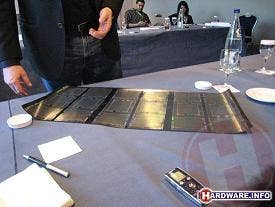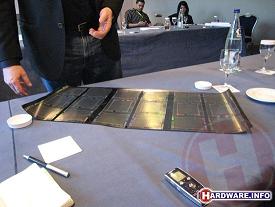HP’s Newest Flexible Displays Will Be Rolled Out Like Newspaper

Share
At a recent meeting in Barcelona, Hewlett Packard's CTO Phil McKinney demonstrated their latest absurdly thin flexible display. Developed using Self-aligned Imprint Lithography (SAIL) these video screens can be made in large quantities on mylar backing allowing them to flex and deform while they work. During manufacturing they are rolled out like a newspaper. According to Hardware.info, the first products using these displays will arrive in two years, with mass production following a year after. McKinney was quick to point out that the current SAIL printed screens are not made to roll and unroll (after production) and that they would fail after half a dozen or so such curls. The SAIL displays are still very flexible, however, and are likely to be seen in ultra thin tablet PCs and other more novel applications. We've got a brief clip of the SAIL display for you below, brought to you by Hardware.info.
We've seen flexible displays before; in fact, we've seen SAIL displays before. The HP screens were developed with Arizona State University who has been demoing the amazing technology for the past two years. It's good to see, however, Phil McKinney with whole sheets of the SAIL made display, and talking about a plan for putting the screens into mass production (relatively) quickly. That's a good sign that we'll soon wade through the easy-to-predict applications and get to more innovative devices soon. Tablet PCs and mobile displays are great, and watching them get thinner is sure to be interesting. What I'm really excited about, however, is the upcoming possibilities of actually putting flexible displays on flexible devices. Video screens that you wear like clothing, wallpaper that can become a TV, embedded displays on every surface - these are the devices that will really wow us. If HP really gets their SAIL manufactured screens on the mass market in three years, we could see some of these ideas follow shortly there after.
Here's a short and sweet look at the razor thin SAIL manufactured HP flexible displays still in the sheet they rolled out on. Pretty amazing.
So what's the big deal about these screens being so flexible? Wouldn't watching something on a curved surface be jarring? Yes, but only until we find ways of taking advantage of that curve to produce some amazing 3D effects. More importantly, the flexibility of these screens is paired with some great durability. Not only may these screens bend to go anywhere, they'll survive once they get there. Check out this demonstration from ASU back in 2008. Current screens now are in color and can handle faster graphics.
Be Part of the Future
Sign up to receive top stories about groundbreaking technologies and visionary thinkers from SingularityHub.


What Phil McKinney didn't announce, and what I was hoping to hear more about, was the power draw, brightness and speed of the screen. Are these things going to be as fast and clear as non-flex screens? We also can't forget that as these displays get thinner and lighter, the associated batteries, processors, and other electronics have to shrink along with them. Part of what makes the iPad so promising is that Apple developed all of these systems simultaneously. Hopefully HP (and ASU) will soon give us a better idea if these SAIL screens aren't just durable, flexible, and thin, but also high definition, ultra low power, and easily integrated.
The movement away from photolithography and its limitations is a good thing, and will help keep us on a trend of exponential growth for improvements in video screens. I'm not sure SAIL is the ultimate solution to making cheaper, thinner, more flexible screens, but it's certainly a good step. Eventually these displays will be able to be rolled and unrolled at will, even crumpled or otherwise severely deformed, without missing a beat. That's going to let designers rethink computers and our modern world. A desktop work station makes sense in some cases, but there are so many more other options. Wouldn't you like your windows to double as video displays - you could turn every apartment into an ocean-view luxury pad. Every surface around us could become a vibrant output device. Sure, it will make commercials even more annoying, but it's a step towards a merger between the physical and digital worlds. Exciting stuff, and it looks like it's arriving sooner rather than later.
[image credits: Hardware.info]
[video credits: Hardware.info, ASU]
[source: Hardware.info (Google Translated from Dutch)]
Related Articles

How Scientists Are Growing Computers From Human Brain Cells—and Why They Want to Keep Doing It

These Brain Implants Are Smaller Than Cells and Can Be Injected Into Veins

This Wireless Brain Implant Is Smaller Than a Grain of Salt
What we’re reading
